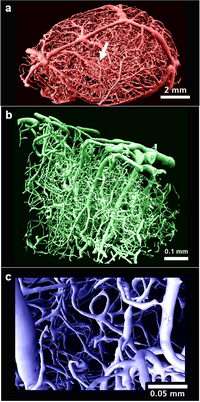New phase-contrast microscopy developed at PSI enhances X-ray images

Imaging techniques are increasingly at the forefront of progress in science and technology. The Paul Scherrer Institute (PSI) is among the leaders in this development. Imaging techniques turn objects visually inside out, allowing ever greater precision– for instance in medical diagnosis. They also contribute to a better understanding of the mechanisms of certain diseases, like Alzheimer's or osteoporosis. Further applications occur in materials research, where imaging processes are a decisive factor in achieving results that ultimately – as with medical progress – benefit society.
The new phase-contrast microscopy developed at PSI enhances the sensitivity and contrast of classical X-ray images. Traditional techniques are based on the different X-ray absorbance of different materials, which enables the structure of dense body-matter like bones to be readily differentiated from that of lighter tissue. Low-absorbance materials, however, produce low-contrast images, which makes it difficult to visually reproduce fine details using conventional X-ray methods.
It has been discovered, however, that X-rays not only lose intensity when passing through a sample, they also undergo a phase shift, because the speed of light waves in matter differs from their speed in a vacuum. This phase shift is sensitive to the smallest changes in tissue, which means that phase signals can be used to substantially heighten the contrast of an X-ray picture.
Safer early diagnosis of breast cancer
Enhanced contrast enables the X-ray dose to be significantly reduced, which is particularly relevant to mammography techniques in screening for breast cancer. Phase-contrast microscopy is readily adaptable to existing X-ray equipment and could, therefore, trigger a major improvement in future X-ray diagnostic techniques.
Another aspect of medical technology currently at the top of PSI's research programme is X-ray microtomography, a process that provides a detailed image of the interior of a sample. PSI results are of particularly high quality because the Swiss Light Source (SLS) particle accelerator generates X-rays of unparalleled intensity. The more intensive the X-ray beam, the better and faster the microtomography. Three dimensional images with a resolution of one thousandth of a millimeter (1 micrometer) can currently be produced within minutes.
Top quality 3D images
The PSI equipment can take snapshots of aluminum alloys, ceramics, and prehistoric embryos, as well as bones affected by osteoporosis. A joint research project of PSI, ETH Zurich, the University of Zurich and Novartis is looking for traces of Alzheimer's disease in blood vessels. Scientists have recorded changes to blood vessels in the brains of young mice with Alzheimer's disease. This might indicate that the -origins of the disease are connected with insufficient blood supply to the brain – in other words that the protein deposits typical of Alz-heimer's might be caused by lack of oxygen. Achieving a resolution of 1–15 micrometers, PSI's 3D imaging of mouse blood vessels is an important tool in researching this hypothesis.
PSI's two neutron radiography instruments, NEUTRA and (since 2005) ICON, are basically no more than large-scale cameras. But they have special powers – they can see through objects without destroying them. So can X-ray devices; but the difference is that neutrons can do this with heavy metals like lead or uranium. And they have other advantages, too. For examining finely structured organic substances (and water) the neutron beam is definitely the instrument of choice.
Roman swords and dino vertebrae
The equipment is often used for routine jobs like the examination of welds and seams, or testing for corrosion, or for electro-chemical and geological research. But questions also come from archaeologists interested in Celtic coins or in the workmanship of Roman swords, from palaeontologists studying the cervical vertebrae of dinosaurs, and even from engineers testing bullet-proof vests.
Last year PSI spent almost SF 270 million not only on its in-house research projects, but also in academic training, and in its function as one of the top user laboratories worldwide. In 2005 a record number of more than 1400 scientists from 50 different countries used our large scale facilities for their experiments, and the number of user-visits was also substantially higher than in the previous year. The quality of PSI's experimental facilities and equipment, as well as our advice and consultation services, is clearly a factor that attracts scientists in increasing numbers to Villigen.
Source: Paul Scherrer Institut

















